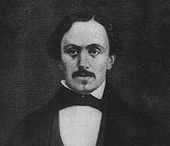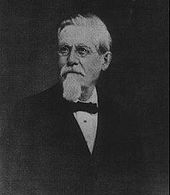- Himno Nacional Mexicano
-
Himno Nacional Mexicano English: National Anthem of Mexico
National anthem of
 Mexico
Mexico
Also known as Mexicanos, al grito de guerra
English: Mexicans, at the cry of warLyrics Francisco González Bocanegra, 1853 Music Jaime Nunó Roca, 1854 Adopted 1943 Music sample Himno Nacional Mexicano (Instrumental)The National Anthem of Mexico (Spanish: Himno Nacional Mexicano) started being used in 1854, although it was not officially adopted by law until 1943. The lyrics of the national anthem, which allude to Mexican victories in the heat of battle and cries of defending the homeland, were composed by poet Francisco González Bocanegra in 1853. In 1854, Jaime Nunó composed the music which now accompanies González's poem. The anthem, consisting of ten stanzas and a chorus, effecitvely entered into use on September 16, 1854. In addition, the National Anthem was played for the first time in public at The Opera Theatre in the city of Matamoros, Tamaulipas.[1]
Contents
Composition
Lyrics competition
On November 12, 1853, President Antonio López de Santa Anna announced a competition to write a national anthem for Mexico. The competition offered a prize for the best poetic composition representing patriotic ideals. Francisco González Bocanegra, a talented poet, was not interested in participating in the competition. He argued that writing love poems involved very different skills from the ones required to write a national anthem. His fiancée, Guadalupe González del Pino (or Pili), had undaunted faith in her fiancé's poetic skills and was displeased with his constant refusal to participate in spite of her constant prodding and requests from their friends. Under false pretenses, she lured him to a secluded bedroom in her parents' house, locked him into the room, and refused to let him out until he produced an entry for the competition. Inside the room in which he was temporarily imprisoned were pictures depicting various events in Mexican history which helped to inspire his work. After four hours of fluent (albeit forced) inspiration, Francisco regained his freedom by slipping all ten verses of his creation under the door. After Francisco received approval from his fiancée and her father, he submitted the poem and won the competition by unanimous vote.[2] González was announced the winner in the publication Official Journal of the Federation (DOF) on February 3, 1854.
Music competition
A musical composition was chosen at the same time as the lyrics. The winner was Juan Bottesini, but his entry was disliked due to aesthetics. This rejection caused a second national contest to find music for the lyrics.[3] At the end of the second contest, the music that was chosen for González's lyrics was composed by Jaime Nunó, a Spanish-born band leader. At the time of the second anthem competition, Nunó was the leader of several Mexican military bands. He had been invited to direct these bands by President Santa Anna, whom he had met in Cuba. About the time that Nunó first came to Mexico to start performing with the bands, Santa Anna was making his announcement about creating a national anthem for Mexico. Out of the few musical compositions submitted, Nunó's music, titled "God and Freedom" (Dios y libertad), was chosen as the winner on August 12, 1854.[4] The anthem was officially adopted on Independence Day, September 16 of that same year. The inaugural performance was directed by Juan Bottesini, sung by soprano Claudia Florenti and tenor Lorenzo Salvi at the Santa Anna Theatre (now known as the National Theatre of Mexico).[3][5]
Lyrics
Officially since 1943, the full national anthem consists of the chorus, 1st stanza, 5th stanza, 6th stanza and 10th stanza. The modification of the lyrics was ordered by President Manuel Ávila Camacho in a decree printed in the Diario Oficial de la Federación.[6] When the anthem is played at sporting events, such as the Olympic Games, the only parts of the anthem that are played are the chorus, 1st stanza and the chorus. When opening and closing television and or radio programming, stations have sometimes played a modified national anthem consisting of the chorus, 1st stanza, chorus, 10th stanza and chorus.
Coro:
Mexicanos, al grito de guerra
el acero aprestad y el bridón.
Y retiemble en sus centros la Tierra,
al sonoro rugir del cañón.
Y retiemble en sus centros la Tierra,
al sonoro rugir del cañón!Chorus:[4]
Mexicans, at the cry of war,
make ready the steel and the bridle,
and may the Earth tremble at its centers
at the resounding roar of the cannon.
and may the Earth tremble at its centers
at the resounding roar of the cannon!Estrofa I:
Ciña ¡oh Patria! tus sienes de oliva
de la paz el arcángel divino,
que en el cielo tu eterno destino
por el dedo de Dios se escribió.
Mas si osare un extraño enemigo
profanar con su planta tu suelo,
piensa ¡oh Patria querida! que el cielo
un soldado en cada hijo te dio.First Stanza:
Let gird, oh Fatherland!, your brow with olive
by the divine archangel of peace,
for in heaven your eternal destiny
was written by the finger of God.
But if some enemy outlander should dare
to profane your ground with his sole,
think, oh beloved Fatherland!, that heaven
has given you a soldier in every son.Estrofa V:
¡Guerra, guerra sin tregua al que intente
De la patria manchar los blasones!
¡Guerra, guerra! Los patrios pendones
En las olas de sangre empapad.
¡Guerra, guerra! En el monte, en el valle
Los cañones horrísonos truenen,
Y los ecos sonoros resuenen
Con las voces de ¡Unión! ¡Libertad!Stanza V:
War, war without quarter to any who dare
to tarnish the coats of arms of the country!
War, war! Let the national banners
be soaked in waves of blood.
War, war! In the mountain, in the valley,
let the cannons thunder in horrid unison
and may the sonorous echoes resound
with cries of Union! Liberty!Estrofa VI:
Antes, patria, que inermes tus hijos
Bajo el yugo su cuello dobleguen,
Tus campiñas con sangre se rieguen,
Sobre sangre se estampe su pie.
Y tus templos, palacios y torres
Se derrumben con hórrido estruendo,
Y sus ruinas existan diciendo:
De mil héroes la patria aquí fue.Stanza VI:
O, Fatherland, ere your children, defenseless
bend their neck beneath the yoke,
may your fields be watered with blood,
may their foot be printed in blood.
And may your temples, palaces and towers
collapse with horrid clamor,
and may their ruins continue on, saying:
Of one thousand heroes, here the Fatherland began.Estrofa X:
¡Patria! ¡Patria! Tus hijos te juran
Exhalar en tus aras su aliento,
Si el clarín con su bélico acento
los convoca a lidiar con valor.
¡Para ti las guirnaldas de oliva!
¡Un recuerdo para ellos de gloria!
¡Un laurel para ti de victoria!
¡Un sepulcro para ellos de honor!Stanza X:
Fatherland! Fatherland! your children swear to you
to breathe their last for your sake,
if the bugle with its bellicose accent
calls them together to battle with courage.
For you, olive wreathes!
A memory for them of glory!
For you, a laurel of victory!
A tomb for them of honor!Copyright status
An urban legend about the copyright status of the anthem states that years after its first performance, family sold the musical rights to a German music publishing company named Wagner House. Originally, Nunó was supposed to have turned the music rights over to the state in exchange for a prize from the Mexican government. However, according to the myth, the copyright changed hands again, this time to Nunó himself and two Americans, Harry Henneman and Phil Hill.[7]
In reality, however, this is not correct. It is true that Nunó, Henneman and Hill did register the music with the company BMI (BMI Work #568879), with the Edward B. Marks Music Company as the listed publisher of the anthem.[8] This might be the version that some have suggested is copyrighted in the United States.[9] However, United States copyright law declares the Mexican anthem to be in the public domain inside the United States, since both the lyrics and music were published before 1909.[10] Furthermore, under Mexican copyright law, Article 155 states that the government holds moral rights, but not property rights, of the national symbols, including the anthem, coat of arms and the national flag.[11]
National regulations
In the second chapter of the Law on the National Arms, Flag, and Anthem (Ley sobre el Escudo, la Bandera y los Himnos Nacionales), the national anthem is described in very brief terms. While Articles 2 and 3 discuss in detail the coat of arms and the flag, respectively, Article 4 mentions only that the national anthem will be designated by law. Article 4 also mentions that a copy of the lyrics and the musical notation will be kept at two locations, the General National Archive and at the National Library, located in the National Museum of History (Biblioteca Nacional en el Museo Nacional de Historia).[12]
Chapter 5 of the Law goes into more detail about how to honor, respect and properly perform the national anthem. Article 38 states that the singing, playing, reproduction and circulation of the national anthem are regulated by law and that any interpretation of the anthem must be performed in a "respectful way and in a scope that allows [one] to observe the due solemnity" of the anthem. Article 39 prohibits the anthem from being altered in any fashion, prohibits it from being sung for commercial or promotional purposes, and also disallows the singing or playing of national anthems from other nations, unless you have permission from the Secretary of the Interior (Secretaría de Gobernación) and the diplomatic official from the nation in question. The Secretary of the Interior and the Secretary of Public Education (Secretaría de Educación Pública), in Article 40, must grant permission for all reproductions of the national anthem to be produced, unless the anthem is being played during official ceremonies carried on the radio or television. Article 41 states that the national anthem is required to be played at the beginning or end of radio and television programming. The extra requirement for television programming is that photos of the Mexican flag must be displayed at the same time the anthem is playing. Article 42 states that the anthem may only be used during the following occasions: solemn acts of official, civic, cultural, scholastic or sport character. The anthem can also be played to render honors to the Mexican flag and to the President of Mexico. If the national anthem is being used to honor the national flag or the President, the short version of the anthem is played. Article 43 says that special musical honors may be paid to the President and the flag, but no more than once during the same ceremony. Article 44 says that during solemn occasions, if a choir is singing the anthem, the military bands will keep silent. Article 45 says that those who are watching the national anthem performance must stand at attention (firmes) and remove any headgear. Article 46 states that the national anthem must be taught to children who are attending primary or secondary school; this article was amended in 2005 to add pre-school to the list. The article also states that each school in the National Education System (Sistema Educativo Nacional) will be asked to sing the national anthem each year. Article 47 states that in an official ceremony in which is need to play another anthem, the Mexican anthem will be played first, then the guest's anthem. Article 48 states that at embassies and consulates of Mexico, the national anthem is played at ceremonies of a solemn nature that involves the Mexican people. If the anthem is played outside of Mexico, Article 48 requires that the Secretary of External Relations (Secretaría de Relaciones Exteriores), through proper channels, must grant permission for the national anthem to be played and will also ensure that the anthem is not sung for commercial purposes.[12]
Cultural significance
Upon the writing of the anthem, Mexico was still facing the effects of a defeat in a war with the United States. The country felt demoralized and also divided, due to the loss of nearly half of its territory to the United States. According to historian Javier Garciadiego, who spoke at a 2004 ceremony commemorating the 150th anniversary of the anthem's adoption, the anthem disregards divisions and strife and encourages national unity. On that same date, Mexico City and other parts of the country stopped what they were doing and performed a nationwide singing of the anthem. Individuals from other nations participated, mostly at diplomatic offices or at locations where a high concentration of Mexican expatriates are found. The anthem has also been described as one of the symbols of the "Mexican identity".[9]
On the rare occasions when someone performs the anthem incorrectly, the federal government has been known to impose penalties to maintain the "dignity" of the national symbols. One example is when a performer forgot some of the lyrics at a soccer match in Guadalajara, she was fined 400 MXN by the Interior Ministry and released an apology letter to the country through the Interior Ministry.[13] In addition, the anthem is sometimes used as a tool against people who might not be "true Mexicans". In one case, a young man of Afro-Mexican descent was stopped by police and forced to sing the anthem to prove his nationality.[14] In a separate incident in Japan, police officers asked four men to sing the Mexican anthem after they were arrested in Tokyo on charges of breaking and entering. However, when the men could not sing the anthem, it was discovered that they were Colombian nationals holding forged Mexican passports. They were later charged with more counts on theft of merchandise and money.[15]
Other languages
Though the de facto language of Mexico is Spanish there are still people who only speak indigenous languages. On December 8, 2005, Article 39 of the national symbols law was adopted to allow for the translation of the lyrics into the native languages. The official translation is performed by the National Institute of Indigenous Languages (Instituto Nacional de Lenguas Indígenas).[16]
Officially, the national anthem has been translated into the following native languages: Chinanteco, Hña Hñu, Mixteco, Maya, Nahuatl and Tenek. Other native groups have translated the anthem into their respective language, but it has not been sanctioned by the Government.[17]
Musical score
References
- ^ "Tamaulipas". History.com. http://www.history.com/topics/tamaulipas. Retrieved 4 November 2011.
- ^ David Kendall National Anthems—Mexico
- ^ a b Embassy of Mexico in Serbia and Montenegro Mexican Symbols—Himo. Retrieved March 19, 2006.
- ^ a b President of the Republic—National Anthem for Kids. Retrieved March 15, 2006.
- ^ Secretary of External Relations History of the Mexican Anthem. Retrieved March 15, 2006. (Spanish)
- ^ Administration of Ernesto Zedillo National Symbols of Mexico. Retrieved March 15, 2006.
- ^ LA Weekly DON'T CRY FOR ME, MEXICO; Article about the copyright situation. September 22, 1999.
- ^ BMI Repretoire Himno Nacional Mexicano (BMI Work #568879). Retrieved March 16, 2006.
- ^ a b San Diego Union Tribune Mexicans celebrate 150 years of national anthem with worldwide sing-along September 15, 2004. Retrieved March 15, 2006.
- ^ US Copyright Office Copyright Term and the Public Domain in the United States. Retrieved March 16, 2006.
- ^ Secretary of Education Mexican Copyright Law. Retrieved March 15, 2006 (Spanish)
- ^ a b "Ley sobre el Escudo la Bandera y el Himno Nacionales" (in Spanish) (PDF). Government of Mexico. 2006-06-03. http://gobernacion.gob.mx/archivos/pdf/fomentocivico/LEY_SOBRE_EL_ESCUDO_LA_BANDERA_E_HIMNO_NACIONALES.pdf. Retrieved 2010-03-01.[dead link]
- ^ Associated Press Woman fined for bungling Mexican anthem. October 2004. Retrieved March 20, 2006.
- ^ College Street Journal FP Antonieta Gimeno Attends Conference on Black Mexicans. Retrieved March 20, 2006.
- ^ ABC News Online Japanese police catch Colombian thieves out. Jun 15, 2004. Retrieved March 20, 2006.
- ^ Diario Oficial de la Federación—Decree allowing for translation of the anthem into native languages. December 7, 2005. Retrieved January 11, 2006.
- ^ Comisión Nacional para el Desarrollo de los Pueblos Indígenas Himno Nacional Mexicano en lenguas indígenas
External links
- SEGOB page about the 150th anniversary of the anthem (Spanish)
- MP3 recordings of the anthem (Spanish)
- President of Mexico's page about the anthem, with two recordings (Spanish)
- Full lyrics of the anthem (PDF) (Spanish)
- Chorus and first stanza in 10 native languages (Spanish)
National anthems of North & Central America Independent countries Antigua and Barbuda · Bahamas · Barbados · Belize · Canada · Costa Rica · Cuba · Dominica · Dominican Republic · El Salvador · Grenada · Guatemala · Haiti · Honduras · Jamaica · Mexico · Nicaragua · Panama · Saint Kitts and Nevis · Saint Lucia · Saint Vincent and the Grenadines · Trinidad and Tobago · United StatesDependencies DenmarkNetherlandsAnguilla · Bermuda · British Virgin Islands · Cayman Islands · Montserrat · Turks and Caicos IslandsUnited StatesComplete List · Africa · Asia · Europe · North America · Oceania and the Pacific Islands · South America Categories:- National anthems
- National symbols of Mexico
- Mexican music
- Spanish-language songs
- 1854 songs
Wikimedia Foundation. 2010.





